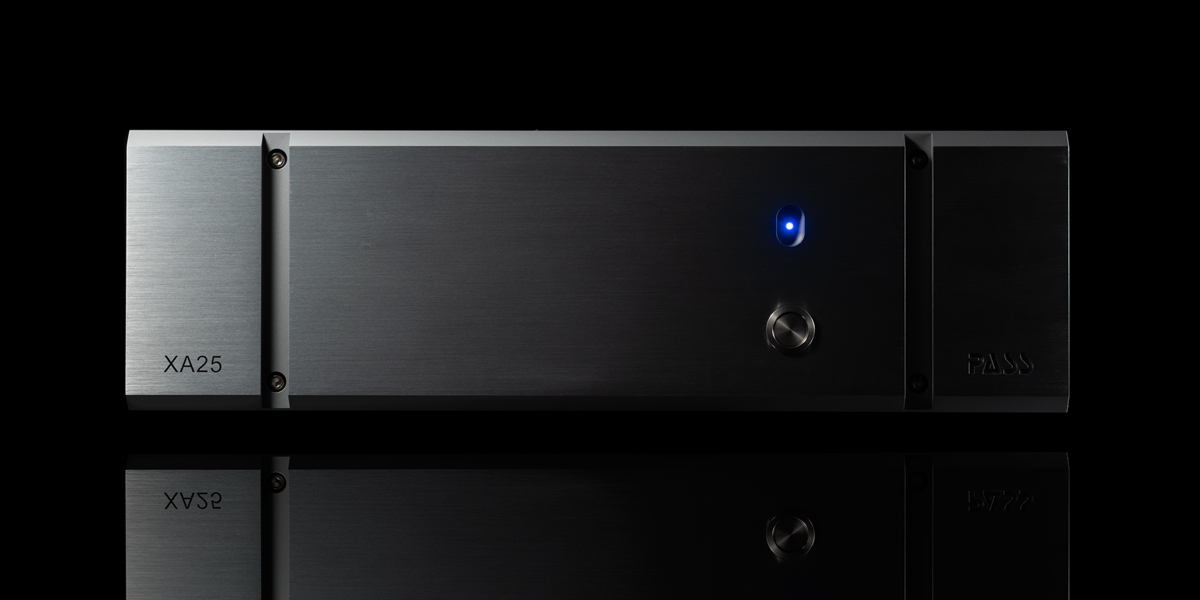Pass Labs XA-25 is the smallest most affordable stereo power amp in the lineup. It’s also a 25wpc Class A type that promises a lot. Today’s finally the day to tell its story. Enjoy!
Little big Pass
I’m no stranger to Nelson Pass’ work. In the past I’ve reviewed FirstWatt F7 and F8 stereo power amplifiers plus Pass Labs HPA-1 headfi deck, XP-12 pre and INT-25 integrated amp. These five adventures are more than enough to understand why Pass Labs is a highly successful well-respected audio house. After more than a decade on the reviewer beat I haven’t yet met a single soul any serious about this hobby who’d think otherwise and say it out loud. Still, up to this point I had this odd sensation of missing one critical experience that would tie all my Pass adventures together. The last piece of the puzzle was sent my way several weeks ago. I patiently stood in line for it for about two years give or take, but I’ll say as early as now that it was well worth it.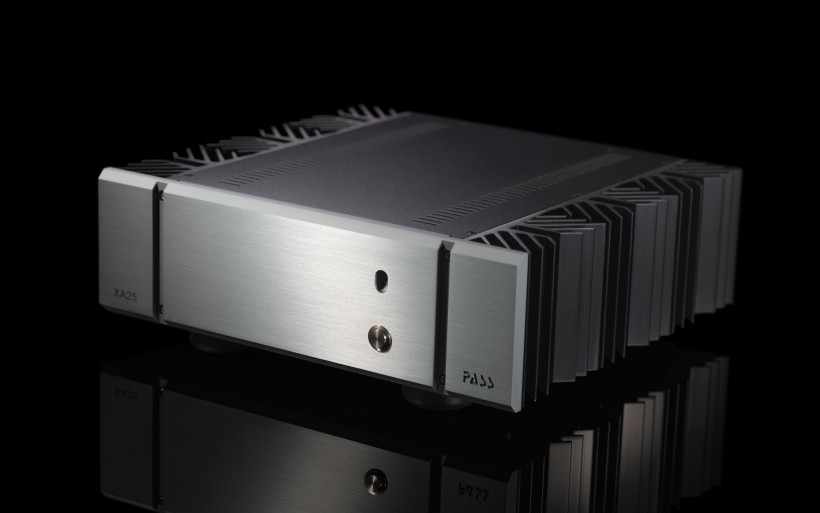 FirstWatt is Nelson Pass’ kitchen table, where the man experiments with minimalist circuits based on just few cherry-picked components only he has in stock. Some of these designs eventually become products with unusual properties tailored for specific loads. Since all these amps don’t go above 25wpc into 8Ω, they’re targeted at listeners who understand how much power their high-efficiency speakers really need. This audience appreciates FirstWatt’s engineering elegance, modest dress code and prices below Pass Labs hardware. The latter brand gets us higher current provision, more power into low-Ω loads, often balanced MO, beefier dissipation surface and fancier albeit still utilitarian casework to boot. On that note, Pass Labs XP-12 designed by Wayne Colburn was one awesome line stage. Ditto Pass Labs INT-25 integrated amp. The latter in fact combines that pre and today’s XA-25 into one chassis, so considering this I should already know this power map. Happy days, case closed then, let’s wrap? Not.
FirstWatt is Nelson Pass’ kitchen table, where the man experiments with minimalist circuits based on just few cherry-picked components only he has in stock. Some of these designs eventually become products with unusual properties tailored for specific loads. Since all these amps don’t go above 25wpc into 8Ω, they’re targeted at listeners who understand how much power their high-efficiency speakers really need. This audience appreciates FirstWatt’s engineering elegance, modest dress code and prices below Pass Labs hardware. The latter brand gets us higher current provision, more power into low-Ω loads, often balanced MO, beefier dissipation surface and fancier albeit still utilitarian casework to boot. On that note, Pass Labs XP-12 designed by Wayne Colburn was one awesome line stage. Ditto Pass Labs INT-25 integrated amp. The latter in fact combines that pre and today’s XA-25 into one chassis, so considering this I should already know this power map. Happy days, case closed then, let’s wrap? Not.
Although some integrated amps allow for bypassing their volume control stage, Pass Labs INT-25 doesn’t thus can’t operate as a power amp. Since most listeners who spend money on such products want to integrate utilities, that’s not even a con. Still, I was curious. The Pass Labs roster is largely built upon power amps after all. Until recently I haven’t had a chance to listen to any of them in my system. That was the big question mark I looked forward to addressing at some point. Just recently the opportunity to finally do that revealed itself. Besides, line stages greatly contribute to the sound our setups make, while I had nearby two excellent such candidates to use with the XA-25 loaner. Happy days indeed!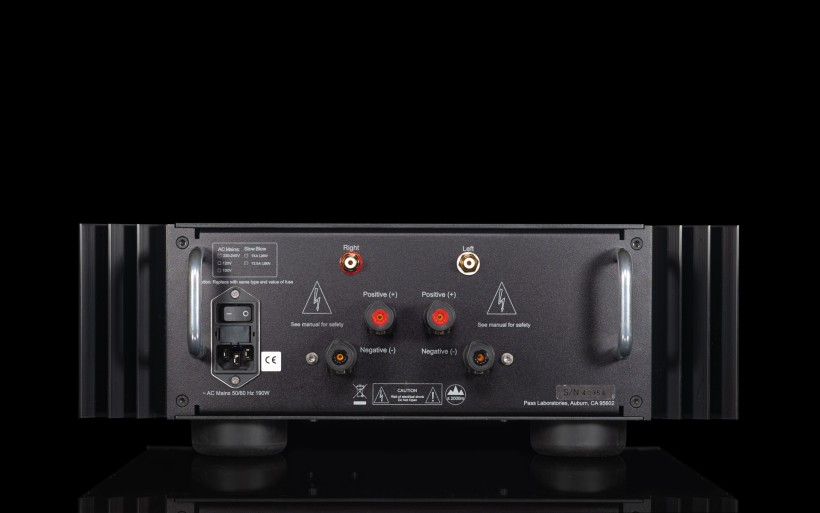 Pass Labs XA-25 was delivered inside a reinforced double cardboard. Two foamy liners nested the key ingredient inside a thick foil bag. Extras included a QC card, manual, spare fuse and standard-issue power cord. Nothing else was needed. The product measures 43.2 x 45.5 x 15.2cm and shows 22kg on the scale, so is regularly sized given its kind and one adult will manage. Although this is the most compact stereo power amp in the Pass Labs offer, it’s still a serious no-frills affair meant to do some real work. Specs list Class A topology, 25/50/100wpc into 8/4/2Ω, 20dB voltage gain, bandwidth up to 100kHz, 0.00x% distortion, 47kΩ/0.012Ω input/output impedance, 40μV output noise, 100V/μS slew rate and power draw of 240W (<1W in idle). Since Pass Labs XA-25 is INT-25 minus the preamp stage, unsurprisingly both boast these very similar impressive figures. The former however sells for noticeably less.
Pass Labs XA-25 was delivered inside a reinforced double cardboard. Two foamy liners nested the key ingredient inside a thick foil bag. Extras included a QC card, manual, spare fuse and standard-issue power cord. Nothing else was needed. The product measures 43.2 x 45.5 x 15.2cm and shows 22kg on the scale, so is regularly sized given its kind and one adult will manage. Although this is the most compact stereo power amp in the Pass Labs offer, it’s still a serious no-frills affair meant to do some real work. Specs list Class A topology, 25/50/100wpc into 8/4/2Ω, 20dB voltage gain, bandwidth up to 100kHz, 0.00x% distortion, 47kΩ/0.012Ω input/output impedance, 40μV output noise, 100V/μS slew rate and power draw of 240W (<1W in idle). Since Pass Labs XA-25 is INT-25 minus the preamp stage, unsurprisingly both boast these very similar impressive figures. The former however sells for noticeably less.
Upon external inspection it’s very clear that Pass Labs XA-25 comprises only essentials that make it one modestly dressed robust looker. It represents simple timeless aesthetic that works for well-aware shoppers who pursue performance and don’t care about bling. Deep Class A bias generates lots of heat that the XA-25’s massive pointy finned radiators efficiently dissipate. Here two rows of perforations on its bonnet also contribute. On the thick horizontally trimmed aluminium forehead we see the secondary on/off button that engages a blue LED in the concaved area just above. Bolts inside two deep vertical recessions on that plate hold it in place and tastefully break the product’s uniform rather conservative dress code. The underbelly features more vents and four large rubber pucks. On the back in-between two steel handles there’s a fused IEC inlet, excellent Furutech FT-807 binding posts and RCA inputs just above. Since today’s subject is an entry-level single-ended Pass, it doesn’t sport XLRs.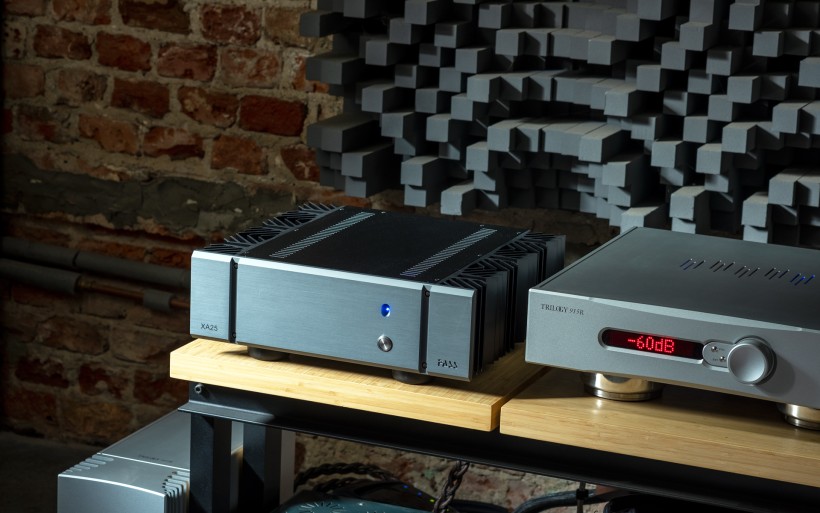 Pass Labs XA25 is a solid-state push-pull DC-coupled design that internally is as minimalist as its exterior. The space under the bonnet is mainly busy with a massive Avel Lindberg toroidal transformer and input board atop a larger filtering/rectification stage with 18 filtering caps. The output stage comprises just two beefy 800-watt/40A Ixys HiPerFET gain transistors per channel, which is a rare sight considering that their work usually falls onto multiple smaller counterparts used in parallel. Most importantly, the entire three-stage circuit of XA-25 doesn’t feature degenerative ballast resistors or any other feedback yet still measures superbly. It’s very low on distortion and output impedance, highly efficient and biased deep into Class A to make reactive low-Ω loads happy. The lack of any feedback and degeneration in this amp also makes room for the undiluted personality of Ixys Fets used in it. The tricky part was in making the product’s gain and bias stable without these measures. You’d have to ask Nelson Pass how he did that.
Pass Labs XA25 is a solid-state push-pull DC-coupled design that internally is as minimalist as its exterior. The space under the bonnet is mainly busy with a massive Avel Lindberg toroidal transformer and input board atop a larger filtering/rectification stage with 18 filtering caps. The output stage comprises just two beefy 800-watt/40A Ixys HiPerFET gain transistors per channel, which is a rare sight considering that their work usually falls onto multiple smaller counterparts used in parallel. Most importantly, the entire three-stage circuit of XA-25 doesn’t feature degenerative ballast resistors or any other feedback yet still measures superbly. It’s very low on distortion and output impedance, highly efficient and biased deep into Class A to make reactive low-Ω loads happy. The lack of any feedback and degeneration in this amp also makes room for the undiluted personality of Ixys Fets used in it. The tricky part was in making the product’s gain and bias stable without these measures. You’d have to ask Nelson Pass how he did that.
Let’s first recap how two years ago the INT-25 fared against the tiny Bakoon AMP-13R, also rated at 25wpc into 8Ω. Then sound|kaos Vox 3afw monitors were the 93dB-sensitive referee very happy about such power output. Just as any other Pass Labs/FirstWatt hardware before it, the INT-25 was groomed for sonic elegance that said nay to wooliness, shout and harshness, yet brimmed with textural richness, vividness, expression and sensuality. This tastefully mature voicing was also enjoyably organic and tactile. Its open vast breathing spaces were busy with virtual shapes projected naturally from within inky canvas rather than being rendered via extensive chiseling and high treble provision. The effect was as easeful as it was fatigue-free. To encapsulate, the Pass finely combined tone, resolution and momentum without overdoing any of these traits.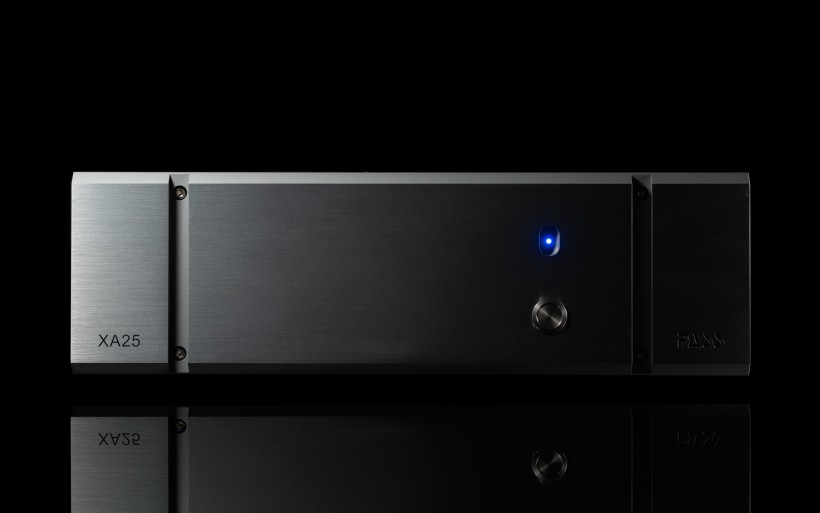 sound|kaos petites fronted by the INT-25 evaporated from my room as expected yet didn’t feel like a small bookshelf performer. Rather, these Swiss boxes cast admirably spacious wall of quicksilvery sound that on bass was aspirated for admirably low reach, hard hits, sensible heft, elasticity and perfect composure. The Pass had them in control firm enough to present larger pleasantly angrier speaker specimens than their size implied. Perceived tonal warmth means elevated richness and round edges, albeit often at a cost of handicapped treble energy and some veil. That wasn’t the sound I’d heard. The INT-25/Vox combo was spatially too liberated and zesty to just slap these labels on its performance and carry on. The core aroma was to a degree mildly warm and round indeed, yet predominantly earthy, sweet and just a touch acidic to add that extra fragrance into the mix and tie everything together. To simplify, back then I’ve made a remark that this profile was closer to a spiced up R-2R than Burr-Brown or Sabre DAC. Nothing about the Pass was overly darkish, chubby and stale, not in the slightest. Actually, it was as generous on tone as it was agile, articulated and fresh. It was also a brilliant support for the Vox’s full-range traits that make i.e. female voices intimate, seductive and touchable. Overall these two products worked extremely well together.
sound|kaos petites fronted by the INT-25 evaporated from my room as expected yet didn’t feel like a small bookshelf performer. Rather, these Swiss boxes cast admirably spacious wall of quicksilvery sound that on bass was aspirated for admirably low reach, hard hits, sensible heft, elasticity and perfect composure. The Pass had them in control firm enough to present larger pleasantly angrier speaker specimens than their size implied. Perceived tonal warmth means elevated richness and round edges, albeit often at a cost of handicapped treble energy and some veil. That wasn’t the sound I’d heard. The INT-25/Vox combo was spatially too liberated and zesty to just slap these labels on its performance and carry on. The core aroma was to a degree mildly warm and round indeed, yet predominantly earthy, sweet and just a touch acidic to add that extra fragrance into the mix and tie everything together. To simplify, back then I’ve made a remark that this profile was closer to a spiced up R-2R than Burr-Brown or Sabre DAC. Nothing about the Pass was overly darkish, chubby and stale, not in the slightest. Actually, it was as generous on tone as it was agile, articulated and fresh. It was also a brilliant support for the Vox’s full-range traits that make i.e. female voices intimate, seductive and touchable. Overall these two products worked extremely well together.
It didn’t really matter whether the Vox was fronted by the INT-25 or AMP-13R. Both these amps had all the mandatory bases sorted; imaging precision and sizing, smoothness, articulation, tonal mass and capable bass. Here subjective preferences mattered. The Bakoon was snappier, shinier, leaner and here. The Pass was darker, denser, rounder, mellower and there. More importantly, the more oxygenated, instantaneous and explicit former was sufficiently muscular to not feel abnormally lean. The calmer meatier more romantic latter was sufficiently illuminated and quick to not emerge as any grim and/or withdrawn. Both were clear synergistic fits for the Vox, but for different reasons. That was the takeaway.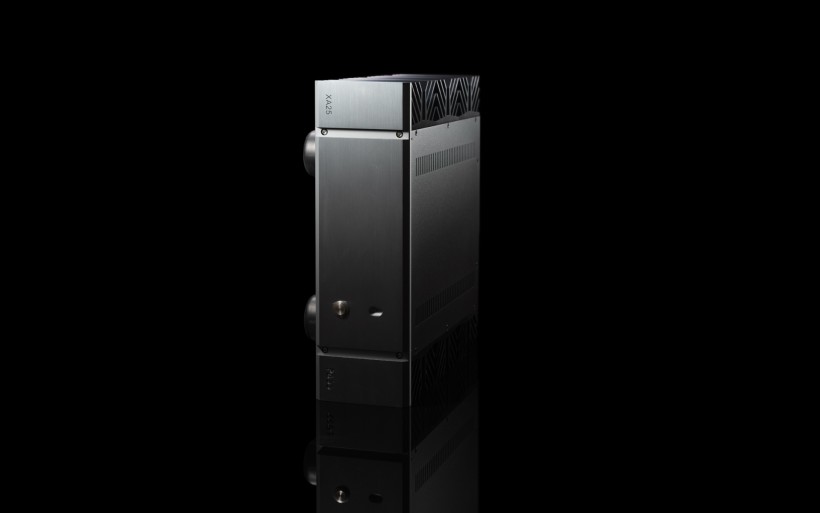 The Bakoon was one unique amplifier. With a copasetic load it was as rapid, elastic and dynamically gifted as it was generous on tone, texturally moist and engaging. In this context the inherently calmer meticulous Pass was remarkably sporty as well with the Vox. The difference between them wasn’t large by any stretch and that was key. With such a fitting speaker companion this amp truly had means to make speed-oriented audience very happy indeed. It simply did that aside other traits it prioritized to keep dullness at bay. Simply put, the INT-25 shifted gears as per my playlist’s demand and was always ready to scale up and go big, while its ability to do so was the quite unexpected awesome asset. Upon replacing the Vox with Boenicke W11 SE+ floorstanders the status quo changed drastically, however. With this challenging load the Bakoon ran out of gas to become shy on internal fill and ease as expected. Here the Pass was far more fierce in comparison; bolder, meatier, more vivid, spatially mightier and with better control over woofers noticeably larger than before. This was a nice reminder that power ratings can be deceptive.
The Bakoon was one unique amplifier. With a copasetic load it was as rapid, elastic and dynamically gifted as it was generous on tone, texturally moist and engaging. In this context the inherently calmer meticulous Pass was remarkably sporty as well with the Vox. The difference between them wasn’t large by any stretch and that was key. With such a fitting speaker companion this amp truly had means to make speed-oriented audience very happy indeed. It simply did that aside other traits it prioritized to keep dullness at bay. Simply put, the INT-25 shifted gears as per my playlist’s demand and was always ready to scale up and go big, while its ability to do so was the quite unexpected awesome asset. Upon replacing the Vox with Boenicke W11 SE+ floorstanders the status quo changed drastically, however. With this challenging load the Bakoon ran out of gas to become shy on internal fill and ease as expected. Here the Pass was far more fierce in comparison; bolder, meatier, more vivid, spatially mightier and with better control over woofers noticeably larger than before. This was a nice reminder that power ratings can be deceptive.
With that out of the way, the firm plan how to handle the XA-25 was formed in a heartbeat. This power amp naturally had to go against its own kind and ideally of similar power output. Trilogy’s costly 50wpc Class A 995R monos were a bit too much, but not Bakoon’s successor Enelum AMP-23R. This 25wpc power amp with adjustable gain disguised as volume control was the ideal sparring partner for the Pass. Since their confrontation is in large part told above, I dusted off my FirstWatt F7. It provided some extra context to fully understand how the XA-25 went about its business. Srajan did the same in his own XA-25 story. It’s time to finally come clean and admit that the XA-25 behaved very much like its integrated sibling two years ago. Considering that the latter housed the former and then some, it was hardly a surprise. Today’s Pass had the same wonderfully complex personality. In my room it sounded like a fully-fledged Class A type that also proved highly adaptive to music that was on the menu. Some tracks revealed quickness and resolution as its main fortes, while others prioritized tonal saturation and color. After several days of auditions I couldn’t detect one clear bias. All listed traits applied this sensibly and carefully formed the product’s finely balanced backbone that didn’t emphasize any specific virtue at a cost of something else. If the XA-25 had any audible weak links, I failed to map them during its stay at my place. Like so it had emerged as a highly versatile product.
It’s time to finally come clean and admit that the XA-25 behaved very much like its integrated sibling two years ago. Considering that the latter housed the former and then some, it was hardly a surprise. Today’s Pass had the same wonderfully complex personality. In my room it sounded like a fully-fledged Class A type that also proved highly adaptive to music that was on the menu. Some tracks revealed quickness and resolution as its main fortes, while others prioritized tonal saturation and color. After several days of auditions I couldn’t detect one clear bias. All listed traits applied this sensibly and carefully formed the product’s finely balanced backbone that didn’t emphasize any specific virtue at a cost of something else. If the XA-25 had any audible weak links, I failed to map them during its stay at my place. Like so it had emerged as a highly versatile product.
Let me stress that the super-insightful zippy Bakoon rendered many amps hooded and slower in the past. Then again, it’s the quickest most open such a product I know and its successor Enleum follows suit on that score. However, the way how we perceive sonics heavily depends on a context. Here the F7 was a nice reminder how quick, punchy, raw, resolved and radiant the XA-25 truly was. To know how that comparison went, replace these amps respectively with the INT-25 and Bakoon and set them apart even more. The FirstWatt felt more distant, rounder, chunkier, lazier, less controlling on bass and a tad hollow there. The smallest Pass was the more illuminated open feistier type that also dug substantially deeper with the Vox and felt more anchored. It was texturally fruitier, here I mean higher saturation and wider color palette, and it presented virtual sound sources as stronger outlined shapes, also served closer to further boost intimacy and directness. As polite upon demand and elegantly voiced as it was, the Pass was clearly the sportier, more intense, instantaneous and engaging amp of the two. Srajan described the F7 in his own XA-25 review as passive in comparison. After conducting my own investigation I couldn’t agree more.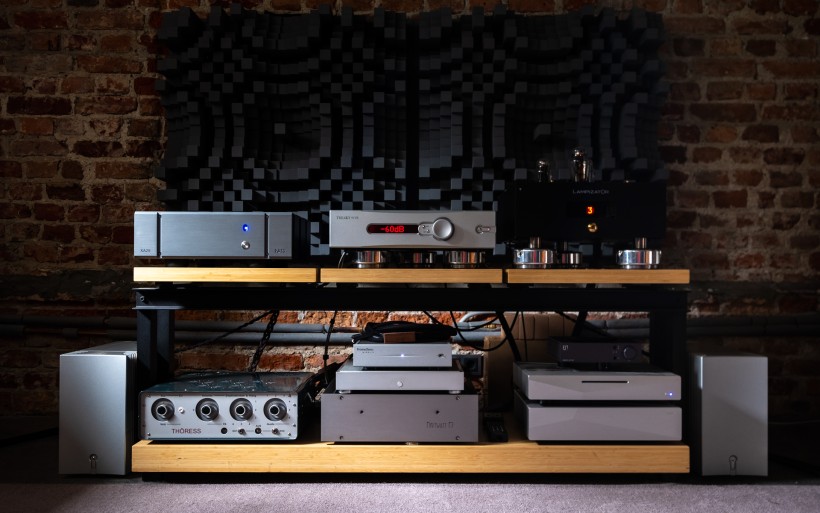 Although these days the F7 doesn’t get as much duty time as it used to, its romantic laid back voicing aged very well. If I had to narrow my toolbox to just one reasonably priced setup, this amp with the Vox would make me very happy. Just so we’re clear, the F7 isn’t just the oldest audio machine I own. This is a keeper that my son will get once he’s ready. However, my fondness towards this now discontinued deck doesn’t change the fact that Pass Labs XA-25 was a substantially higher-tiered product. It had the upper hand on every front there was and impressed my ears far more. Its quicker, spatially more sorted, accurate, powerful, clearer, vivid and intense demeanor marked the clear progression rather than just a different sonic perspective. What I really want to say is that the XA-25 excelled at everything it did and sounded fantastic. It also behaved like a far more powerful power amp than its specs suggested.
Although these days the F7 doesn’t get as much duty time as it used to, its romantic laid back voicing aged very well. If I had to narrow my toolbox to just one reasonably priced setup, this amp with the Vox would make me very happy. Just so we’re clear, the F7 isn’t just the oldest audio machine I own. This is a keeper that my son will get once he’s ready. However, my fondness towards this now discontinued deck doesn’t change the fact that Pass Labs XA-25 was a substantially higher-tiered product. It had the upper hand on every front there was and impressed my ears far more. Its quicker, spatially more sorted, accurate, powerful, clearer, vivid and intense demeanor marked the clear progression rather than just a different sonic perspective. What I really want to say is that the XA-25 excelled at everything it did and sounded fantastic. It also behaved like a far more powerful power amp than its specs suggested.
During their fight the Pass and FirstWatt were both connected to the nicely balanced and lively yet costly Trilogy 915R preamp. Considering both contestants’ single-ended pedigree, it was time to replace the internally doubled British device with the twice as affordable single-ended Thöress DFP. The latter is geared for color and tonal mass, while cutting distance to the closest sound sources to present them as bold tall muscular frames is its specialty. This unusual perspective effectively bends soundstage to surround a listener with it, which in turn elevates the sensation of spatial directness and closeness. Vox monitors amplify the effect even more. Although a tubed type, the DFP makes highly agile, energetic and engaging sound. As such it acts like an espresso shot rather than latte, while wide color range, spatial complexity and heft always follow. It’s fair to say that this specific sonic MO is well-pronounced and always sensible. It also takes no rocket scientist to know what may happen upon adding the XA-25’s own rich fruity agile illuminated flavor. The DFP with this amp produced sound that always had me at the edge of my seat in one way or another. The outcome was pure intensity in every sense of the word: tone, imaging size, attack, detail retrieval, sheer substance, raw power and overall excitement. The Pass was very pleased with such a companion driver nearby, and so was I with the result of their conjoined effort. I’ve actually enjoyed myself more than when the 915R was around. This experience also proved me how much more rapid and feistier the XA-25 could still get whilst maintaining its Class A charm and all associated virtues.
In the summary of my story about Pass Labs INT-25 I wrote that many products would like to sound like it. Back then I wasn’t aware of any that could. Today that changed, Pass Labs XA-25 can. It’s visually utilitarian yet classy and built to last generations. It gets by perfectly fine with minimalist i/o, operates flawlessly and is squeaky clean when there’s no playback. It also says hello to preamps and is noticeably more affordable than its integrated sibling yet as awesome where it matters most. There’s nothing to dislike here. If 25wpc is enough for your speakers and you’re after a high-value stereo power amp for them, auditioning Pass Labs XA-25 prior to anything else is my sincere recommendation. It is superb all across the board and worth every penny.
Associated Equipment:
- Amplifier: Trilogy 995R, FirstWatt F7, Enleum AMP-23R
- DAC: LampizatOr Pacific (KR Audio T-100 / Living Voice 300B + KR Audio 5U4G Ltd. Ed.)
- Speakers: Boenicke Audio W11 SE+, sound|kaos Vox 3afw
- Transport: Innuos Statement
- Preamplifier: Trilogy 915R, Thöress DFP
- Speaker cables: Boenicke Audio S3, LessLoss C-MARC
- Headphones: HifiMan Susvara
- Speaker signal conditioning: LessLoss Firewall for Loudspeakers, Boenicke ComDev
- Anti-vibration conditioning: 12x Carbide Audio Carbide Bases (under DAC, preamp and speakers), 3x Bindbreakers (under LessLoss power bar)
- Interconnects: LessLoss Entropic Process C-MARC, Boenicke Audio IC3 CG
- Power components: LessLoss Power Distributor -> Boenicke Audio Power Gate, LessLoss C-MARC, LessLoss Entropic Process C-MARC, ISOL-8 Prometheus
- USB components: iFi audio Mercury3.0
- Rack: Franc Audio Accesories Wood Block Rack 1+3
- Network: Fidelizer EtherStream, Linksys WRT160N
- Music: NativeDSD
Retail prices of reviewed components in EU (excl. VAT):
- Pass Labs XA-25: $4’500
Manufacturer: Pass Labs


